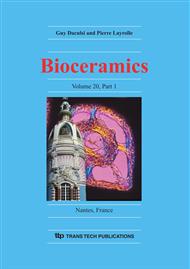p.399
p.403
p.407
p.411
p.415
p.419
p.423
p.427
p.431
Development of In Situ-Formed Interconnected Porous Scaffolds with Low Porosity
Abstract:
Biocompatible and water-soluble fibers (sodium carboxymethyl cellulose (CMC)) were fabricated via a wet-spinning method. The CMC fibers/ polymethyl methacrylate (PMMA) mixtures and CMC fibers/Poly (L-lactide-co-glycolide-co- -caprolactone) (PLGC) mixtures were prepared by a heat-kneading method. For CMC fibers/PMMA, after removal of the CMC fibers from the mixtures, the interconnected porous scaffolds with porosity from 27.79 % to 60.98 % (volume percent) were obtained. For CMC fibers/PLGC, the interconnected porous scaffolds with porosity 38.55 % and 76.83 % (volume percent) were prepared. The solid CMC fibers/PLGC mixtures had the higher ultimate tensile strength and Young, s modulus than those of porous PLGC scaffolds.
Info:
Periodical:
Pages:
415-418
Citation:
Online since:
November 2007
Authors:
Price:
Сopyright:
© 2008 Trans Tech Publications Ltd. All Rights Reserved
Share:
Citation:


